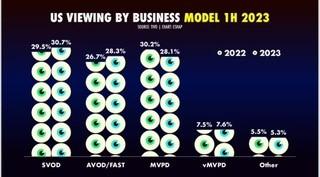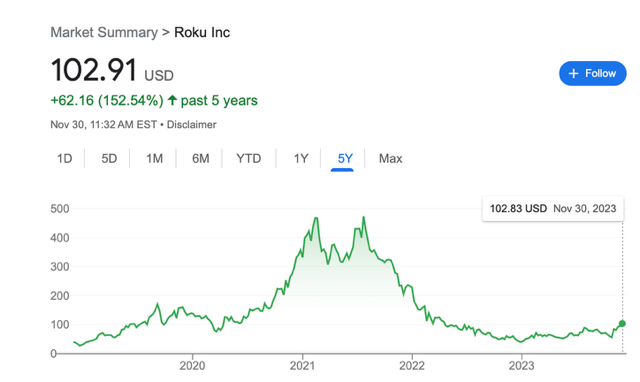
To listen to an audio version of this article click here.
1. Hybrid Viewing FTW
A recent study from our friends at Hub Entertainment Research shows that more viewers now start their TV viewing journeys via an app of some sort versus an actual set top box.
This does not, as you may have read, mean that “streaming is winning.”
It just means that set top boxes are losing.
Not that this should be a surprise. No one likes set top boxes. Certainly not the MVPDs who need to waste valuable resources on installing and servicing them. And certainly not consumers who need to use multiple remotes to “input switch” from set top boxes to streaming and back again.
Because, lest you forget, hybrid viewing is still the norm. While the numbers are shrinking, most US households have a pay-TV subscription of some sort. And a couple of streaming subscriptions. And the fact that they are embracing that hybrid reality is really the key takeaway from the Hub study.
Why it matters
Pay TV is moving to streaming.
vMVPDs, like YouTube TV and Hulu Live TV, now have around 15 million subscribers, via Leichtman Research. And, as Evan Shapiro has pointed out, MVPD streaming apps like the Spectrum Reach app, are also drawing in big numbers of viewers—Spectrum’s app has the same percentage of streaming viewership as YouTube TV.
MVPDs are also, you might recall, actively pushing their own streaming devices—Charter and Comcast’s new Xumo box being just the latest example.
So there’s that too, and, for all the reasons I ticked off earlier, we’re going to see more of that, not less.
The biggest takeaway here though is that hybrid viewing is still the norm as this chart from Shapiro (using TiVo data) shows.

That is what is key to remember. That while there are indeed some people who only watch streaming and some who only watch pay TV, most people watch some of both. And that their splits often vary depending on the time of year and what is on. So an NFL fan may watch a lot more pay TV in the fall and winter during football season and a lot more streaming in the spring.
The other notable takeaway of the Hub study is that smart TV-based apps are being used around twice as much as dongle-based apps. Which would seem to confirm the ongoing death of the dongle, as smart TVs’ native interfaces continue to improve, and as both Roku and Amazon roll out their own TV sets.
Again, this isn’t so much news, as confirmation of something we already knew.
What you need to do about it
If you are an advertiser, hybrid viewing is something you will need to continue to adapt to, at least for the next three to five years. Viewers like streaming shows, many will start their viewing journey on streaming, but they’ll also head back to pay TV for local news and sports.
You need to figure out how to best target them, how to separate the heavy streaming viewers from the heavy pay TV viewers and the 50-50 viewers. Because that is how you are going to reach your audience going forward.
If you are an MVPD and you haven’t looked into moving away from old school set top boxes, that’s a problem. The better fixed 5G wireless broadband gets, the more likely it is you will have competition, the more important it is that you give your customers what they want.
Which is definitely not a set top box.
2. Wall Street Falls Back In Love With Roku
Wall Street has never quite known what to make of Roku. For many in the financial community, the company’s advertising + device dual-revenue strategy often seems to call to mind the old SNL “it’s a floor wax and a dessert topping!” skit.
(The fact that numerous other companies have adopted the same strategy has not seemed to alter that perception.)
So it should come as a surprise to learn that Roku’s stock is up 150% since January at a time when most other media stocks have not seen anywhere near that jump.

Why it matters
It’s not so much that Roku’s done anything remarkable, but rather, that the market seems to have caught up to Roku.
First, there’s the ad market. As of Q3 2023, Roku’s ad sales were up 33% YOY. That’s a sizable increase and Roku is in an excellent position for it to grow even more.
Right now, there’s not a whole lot of ad inventory on streaming. The ad-supported versions of the various SVOD services are still getting started, which leaves Hulu and the FASTs. Roku is a well-known name (in the US anyway) and has been at it long enough to build up relationships with advertisers. They also reach a very broad audience when you combine their smart TVs (or smart TVs with the Roku OS built in) and their dongles.
Granted, money has been flowing to all the OEMs in the space—Roku’s size just means that proportionally they get more of it.
Roku also has a strong brand name with consumers. While their interface is contentious, with both lovers and haters, its iPhone-like design makes it different than most of its competitors, which gives it a unique advantage. That may explain why the number of “active monthly subscribers” jumped in Q3 2023 as well, with 75.8 million accounts, an increase of 2.3 million, versus the expected 1.8 million.
Finally, despite all the good financial news, Roku laid off around 200 staffers in a stated attempt to bring costs under control. Which is the exact sort of behavior Wall Street likes to see.
What you need to do about it
If you are an investor and you own Roku stock, which has been crashing and burning since 2021 (when it was at around 4X what it is today), some small reasons to rejoice.
Though, like us, I suspect you are more focused on who you think might actually buy Roku, a company whose sale has been the subject of furious speculation for years.
That’s because while Roku has close to 75 million users in the US, its overseas presence remains fairly nil (they’re the baseball of streaming devices.) So while whoever bought them would gain a huge slice of the US market, they’d then need to take the device and its interface and figure out a way to make it work internationally.
Most every company in the industry has been tapped as a potential buyer, from Microsoft (which lacks any real TV interface) to Apple (whose Apple TV interface most closely resembles Roku’s) to Netflix (one of Roku’s earliest investors) to Sony (which lacks its own OS) and then some.
The reality is that no one may buy it, because the OS Wars are already well under way, something you can read about in our upcoming Special Report due out early 2024. Meaning Roku may just wind up being a local hero in the US.
Or not.
If you’re an advertiser and you’re looking for streaming inventory, Roku and the other smart TV OEMs definitely have some for you, along with the ability to track and measure your campaigns via their own proprietary ACR data. They have proven to be great reach extension vehicles, and if you’re not investing your money across the Big 4 (LG, Roku, Samsung and VIZIO) you’re missing out.
If you are the other three of the big four, Roku’s success is good news for you as well, as it means Wall Street is finally understanding the dual revenue strategy. Or at least pretending they do.
If you’re someone who generally turns on the TV knowing exactly what you want to watch, then Roku’s interface may be right for you. That’s something I learned while researching the aforementioned OS Wars report—that Roku and Apple TV were designed at a time when there wasn’t much available on streaming and so viewers went in looking for something specific, whereas newer interfaces were designed for viewers who turned on the TV and then decided to look for something to watch. Hence the array of title choices and options on the home screen.
Alan Wolk is co-founder and lead analyst at the consulting firm TV[R]EV. He is the author of the best-selling industry primer, Over The Top: How The Internet Is (Slowly But Surely) Changing The Television Industry. Wolk frequently speaks about changes in the television industry, both at conferences and to anyone who’ll listen.
Week in Review is an opinion column. It does not necessarily represent the opinions of StreamTV Insider.